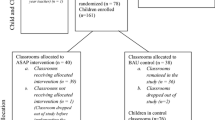Abstract
A participant-observer spent 11 weeks as a teacher's assistant in a preschool classroom that utilized full inclusion and integrated therapy. Observations focused on three children with special learning needs. Qualitative analysis of the participant-observer's field notes yielded six themes: (1) integrated therapy and teacher facilitation are highly similar interventions, (2) integrated therapy and teacher facilitation require the same set of components, (3) social competence is the ultimate goal of services, (4) receptive language creates a feedback loop between social competence and services, (5) behavioral consultation occurs between the therapist and the teacher, and (6) teachers imitate therapists much more than vice versa. These themes were integrated in a descriptive model of early intervention services. Implications for practice and future research are discussed.
Similar content being viewed by others
REFERENCES
Bandura, A. (1977). Social learning theory. Englewood Cliffs, NJ: Prentice Hall.
Buysse, V., & Bailey, D. B. (1993). Behavioral and developmental outcomes in young children with disabilities in integrated and segregated settings: A review of comparative studies. Journal of Special Education, 26, 434–461.
Gallivan-Fenlon, A. (1994). Integrated transdisciplinary teams. Teaching Exceptional Children, 26(3), 16–20.
Guralnick, M. J. (1990). Social competence and early intervention. Journal of Early Intervention, 14, 3–14.
Hart, B., & Risley, T. R. (1975). Incidental teaching of language in the preschool. Journal of Applied Behavior Analysis, 8, 411–420.
Marshall, C., & Rossman, G. (1989). Designing qualitative research. Newbury Park, CA: Sage.
Odom, S. L., & McEvoy, M. A. (1990). Mainstreaming at the preschool level: Potential barriers and tasks for the field. Topics in Early Childhood Special Education, 10, 48–61.
Odom, S. L., & Ogawa, I. (1992). Direct observation of young children's social interactions with peers: A review of methodology. Behavioral Assessment, 14, 407–441.
Plimpton, G. (1964). Paper lion. New York: Harper and Row.
Pryzwansky, W. B. (1977). Collaboration or consultation: Is there a difference? Journal of Special Education, 11, 179–182.
Author information
Authors and Affiliations
Corresponding author
Rights and permissions
About this article
Cite this article
Pohlman, C., McWilliam, R.A. Paper Lion in a Preschool Classroom: Promoting Social Competence. Early Childhood Education Journal 27, 87–94 (1999). https://doi.org/10.1023/A:1026096110653
Issue Date:
DOI: https://doi.org/10.1023/A:1026096110653




